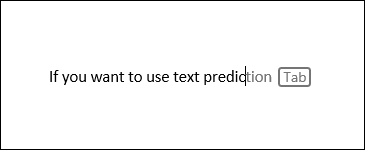Oh man I know some folks who would go nuts for that.
Ha, I assumed it was an Osu! micro-keeb for a second there. 
Oh man I know some folks who would go nuts for that.
Ha, I assumed it was an Osu! micro-keeb for a second there. 
I’m using predictive text generation for code and email everyday now and find myself absolutely dependent on the Tab key.

Historically, this key got zero attention from me and was perfectly managed by my non-dominant hand’s wimpiest digit.
Has anyone started mapping this key somewhere else and do you also feel this tech somewhat diminishes the need to actually type anymore?
While not with the Tab key, I have found myself making small changes to a given keeb’s setup depending on what I’m using it for.
Main case in point, my work keyboard I use for prepress and layout - which involves lots of navigating (my 65s always have 4 nav-keys on the right-hand column), and sometimes lots and lots of shortcuts using the Command key. For those days when I know I’ll be hitting that Command key from a weird angle a few thousand times at least, I’ll flip it around backwards just like I do with my space bars all the time - and my thumb thanks me for it.
As for autocomplete - this may be my neuro-weirdness showing, but I almost always prefer typing the entire words complete with punctuation - even on a phone. I can’t say I have a clear reason for that on the tip of my tongue, but thinking about it this may be at least partially in-service of maintaining my train of thought, which is generally extremely tenuous. I like communicating quickly and generally love things that save me time, but when it comes to typing, I prefer the long way home.
I also just love typing, if that wasn’t already super-obvious. ![]()
Nice. That’s really clever actually.
Same here. I do write a ton less these days. It’s mostly me starting a thought, and AI completing it for me.

What is that recent trend of flex all about?
Preferences are personal of course, but I like my keyboards like my bed’s mattress: hard.
Thinking of it, what use are all those well-defined key switch pressure graphs, when the key switch’s response becomes variable with its location on the board?
However, what worries me the most, is that some keyboard manufacturers now seem to think that everybody wants flex.
Not so long ago, I had to deflex an Akko ACR Pro 68 by placing 4 mm thick felt plates below the PCB. Instead of removing the thick paper covering the sticky side, I left it on, touching the PCB. This resulted in a kind of tape mod and dampening all in one. The whole turned out to be my currently best sounding keyboard with insane, almost musical thock.
It’s basically the hype beast side of the hobby taking things to far again. IME a little flex or bounce can make for a great typing experience. Problem is a lot of these OEMs saw how popular mountings that allowed for that little bit of flex/bounce were & took them to their extremes right out the gate.
I don’t get the flex thing at all. I want to feel something solid when I type; flex feels cheap. I want the sensation of typing on an immovable brick, and it’s a dealbreaker when PCBs only come with a ton of flex cuts that seem like they’d just make it more likely to break.
The community preference these days seems to have moved to linears in general, and linears with very long springs that have low spring constants, which mean increased preload/less of a difference between the starting weight and bottom out weight. These two choices mean exaggerated bottom outs, and flex/bounce is a way to mitigate the discomfort from harsh bottom outs so the change in actuation point/response doesn’t matter when everyone bottoms out to begin with.
Otoh like @Rob27shred mentioned a little flex/bounce is ideal, and if you look at the OG Korean boards like the OTD 356n, flex was introduced in the form of thinner PCBs and half plates. The modern method of that is no flex cut thin PCBs with either soft (plastic plates) on hard mounts like top mount to achieve flex, or stiffer plates on soft mounts like foam strip/gummy o-ring for bounce. Top mount with plastic plates and standard 1.6mm FR4 PCBs is a very nice way to achieve a slightly softer but consistent experience.
But in general the keyboard design philosophy has shifted from consistency in typing feel to maximum flex.
For me, just a little flex is perfect - indeed, I’d call it more of a slight “bounce” at that level.
While I own a couple PCBs with a bunch of flex cuts in them, I actually haven’t used any of them yet - but from what I hear, it would be a bit much for my tastes.
The effects I like are the absorption of high-frequency / harsh vibrations, and that tiny bit of give / bounce. It’s not enough that I feel any keys actually moving away from me, so much as they reverberate something like a tight drum head.
If I’m in the mood for something more firm without venturing into the valley of harshness, I go for FR4. It’s genuinely difficult for me to pick an overall favorite between PC and FR4; the majority of my favorite builds have one of the two.
While I’d rarely describe FR4 as bouncy in its own right (unless it has a bunch of flex cuts maybe), it does still take much of any potential edge off (at least with feel, not so much with sound), and bring some nuance to builds I’d otherwise consider harsh.
I have another KBD67 Lite with an FR4 plate; and surprise surprise, I’d rate its harshness between the brass and PC ones. It doesn’t have that punching-steel feeling like the brass one does, nor does it have the slightly bouncy reverb of the PC one.
Of the three KBD67 Lite configs I mentioned, the FR4 one is by far the loudest - but the brass one is still the most harsh both with sound and feel; the sounds are more sharp / piercing. Most of the time, I’ve experienced FR4 as being just flexy enough to blunt the harshness I find unpleasant.
I agree. It’s not the feeling of the PCB bending, but the change in feel of the vibration when you type that makes flex builds appealing.
btw. just because I saw this old post via google - the outcome, after working on this for another 2 years past the original post, is this:
https://thock.film
I finally found a factory that can make 0.2mm silicone that isn’t tearing apart too badly and stays in shape while being very soft. I also redesigned the standard film cutout to make use of all the extra parts that would be waste otherwise:
Here’s a post by a member of the Japanese community showing the films and the use of all extra parts even the tiny parts that are actually trash - he uses the thin inner rectangles under his stabs ![]()
https://twitter.com/aneno_ow/status/1734902452036714499/photo/2